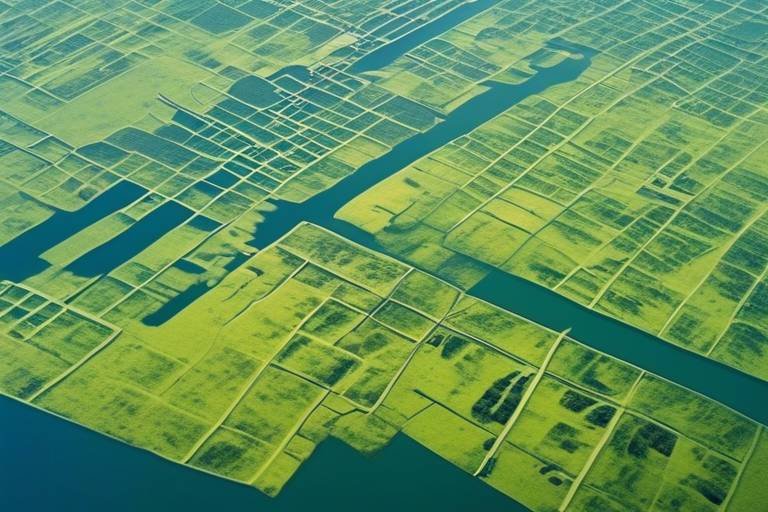Innovations in Biodegradable Materials - The Future of Packaging
In a world increasingly aware of the environmental impact of waste, biodegradable materials have emerged as a beacon of hope for a sustainable future. These innovative materials are designed to break down naturally, reducing the burden of plastic waste that has plagued our planet for decades. Imagine a world where your packaging doesn’t just end up in a landfill but instead returns to the earth, nourishing it rather than harming it. This article explores the latest advancements in biodegradable materials, their impact on the packaging industry, and how they contribute to sustainability and environmental conservation.
At the heart of biodegradable materials is the concept of natural decomposition. Unlike traditional plastics, which can take hundreds of years to break down, biodegradable materials are designed to be processed by microorganisms, returning to the environment in a matter of months. This section dives into the science behind these materials, focusing on their chemical makeup and the biological processes that facilitate their breakdown. For instance, materials like polylactic acid (PLA) and polyhydroxyalkanoates (PHA) are derived from renewable resources, making them not only eco-friendly but also a viable alternative to conventional plastics.
The packaging industry is undergoing a remarkable transformation as manufacturers and consumers alike recognize the need for sustainable options. One of the most exciting trends is the rise of innovative designs that incorporate biodegradable materials. From food containers to shopping bags, companies are rethinking their packaging strategies. For example, many brands are now using compostable films made from plant-based sources, which not only serve their purpose but also align with consumers’ growing desire for environmentally responsible products.
Among the most promising developments in biodegradable materials are plant-based plastics. These materials are crafted from renewable resources, such as corn starch or sugarcane, offering a sustainable alternative to petroleum-based plastics. The production process involves extracting sugars from these plants and converting them into a polymer that can be molded into various packaging forms. The environmental benefits are significant: reducing reliance on fossil fuels, lowering carbon emissions, and promoting agricultural sustainability. However, how do they stack up against traditional plastic alternatives? The answer lies in their ability to decompose under the right conditions, returning to the earth without leaving harmful residues.
The creation of plant-based plastics involves several innovative techniques, including fermentation and extraction. Fermentation is a process where microorganisms convert sugars into organic acids, alcohol, or gases, which can then be transformed into biodegradable polymers. Extraction, on the other hand, involves isolating specific components from plants to create the desired material properties. These methods not only enhance the sustainability of the production process but also reduce the environmental footprint associated with traditional plastic manufacturing.
The adoption of plant-based plastics is on the rise, with many leading brands making the switch to these sustainable materials. However, market trends reveal a mixed landscape. While consumer preferences are shifting towards eco-friendly options, manufacturers face challenges such as higher production costs and limited availability of raw materials. Nevertheless, as technology advances and economies of scale are achieved, the market is expected to expand, making plant-based plastics more accessible to a broader audience.
Another exciting avenue in biodegradable materials is compostable packaging. This type of packaging is specifically designed to break down in composting conditions, turning into nutrient-rich compost that can enhance soil health. The benefits are clear: reducing landfill waste, promoting soil fertility, and supporting a circular economy. Applications for compostable packaging are vast, ranging from food service items to retail packaging, proving that sustainability can be seamlessly integrated into various sectors.
Despite their numerous advantages, biodegradable materials face several challenges that hinder widespread adoption. One major issue is the production costs, which can be significantly higher than traditional plastic options. This economic factor often deters manufacturers from making the switch. Additionally, consumer awareness and education play a crucial role in the success of biodegradable materials. Many consumers are still unaware of the benefits and proper disposal methods for these products, leading to confusion and skepticism.
As previously mentioned, the cost of biodegradable materials can be a significant barrier to their adoption. Factors influencing these costs include the price of raw materials, production processes, and market demand. To overcome this hurdle, manufacturers are exploring various solutions, such as investing in research and development to enhance production efficiency and reduce costs. As the market matures, we may see a decline in prices, making biodegradable options more appealing to both businesses and consumers.
Increasing consumer knowledge about biodegradable materials is essential for their success in the market. Strategies to boost awareness include engaging marketing campaigns, educational initiatives, and collaborations with environmental organizations. By informing the public about the importance of sustainable packaging choices, we can foster a culture that prioritizes eco-friendly products and encourages responsible disposal practices.
- What are biodegradable materials? Biodegradable materials are substances that can be broken down by natural processes, returning to the environment without causing harm.
- How long do biodegradable materials take to decompose? The decomposition time varies depending on the material and environmental conditions, but many biodegradable materials can break down within a few months.
- Are biodegradable materials more expensive than traditional plastics? Generally, yes. The production costs of biodegradable materials can be higher, but prices are expected to decrease as technology advances.
- Can biodegradable packaging be composted? Yes, many biodegradable packaging options are designed to be composted, turning into nutrient-rich compost under the right conditions.

Understanding Biodegradable Materials
Biodegradable materials are a fascinating innovation in the realm of sustainability, designed to break down naturally through biological processes. Unlike traditional plastics that can linger in our environment for hundreds of years, biodegradable materials are engineered to decompose in a relatively short timeframe, often within a few months to a couple of years. This decomposition occurs through the action of microorganisms, such as bacteria and fungi, which consume the material and convert it into natural substances like water, carbon dioxide, and biomass. This remarkable feature not only reduces the volume of waste in landfills but also helps in returning nutrients to the soil, promoting a healthier ecosystem.
The science behind biodegradable materials is rooted in the understanding of polymers—long chains of molecules that make up both natural and synthetic materials. Biodegradable polymers can be derived from renewable resources such as corn starch, sugarcane, or even waste products from agriculture. These materials can be categorized into two main types: bio-based and petrochemical-based. Bio-based biodegradable materials are made from natural sources, while petrochemical-based biodegradable materials are derived from traditional fossil fuels but are designed to break down more quickly than conventional plastics.
One of the most significant advantages of biodegradable materials is their potential to replace traditional plastics in packaging. As consumers become more environmentally conscious, the demand for sustainable packaging solutions is on the rise. Biodegradable materials offer a way to reduce our reliance on fossil fuels and minimize the environmental impact of packaging waste. However, the journey to widespread adoption is not without its challenges, as we will explore in later sections.
To give you a clearer understanding of how biodegradable materials work, consider the following comparison:
| Type of Material | Source | Decomposition Time | Environmental Impact |
|---|---|---|---|
| Traditional Plastic | Fossil Fuels | 100+ years | High |
| Biodegradable Plastic | Renewable Resources | 3-6 months | Lower |
| Compostable Material | Organic Waste | 1-3 months | Very Low |
This table illustrates the stark differences between traditional plastics and biodegradable options, highlighting the urgent need for a shift in our packaging practices. As we move forward, understanding the science and potential of biodegradable materials will be crucial in making informed choices that benefit our planet.
In summary, biodegradable materials are not just a trend; they represent a crucial step toward a more sustainable future. By breaking down naturally and providing a viable alternative to traditional plastics, they hold the promise of reducing pollution and conserving resources. As we delve deeper into the current trends and innovations in biodegradable packaging, we will uncover how these materials are reshaping the industry and paving the way for a greener tomorrow.

Current Trends in Biodegradable Packaging
In recent years, the packaging industry has seen a remarkable transformation, with a growing focus on sustainability and environmental responsibility. As consumers become increasingly aware of their ecological footprint, the demand for biodegradable packaging has surged. This shift is not just a trend; it's a movement towards a more sustainable future. Companies are now racing to innovate and create packaging solutions that are not only functional but also environmentally friendly. In this section, we’ll explore some of the most exciting trends that are shaping the landscape of biodegradable packaging.
One of the most significant trends is the rise of plant-based plastics. These materials, derived from renewable resources such as corn starch, sugarcane, and even algae, are gaining traction due to their lower environmental impact compared to traditional petroleum-based plastics. Manufacturers are increasingly investing in research to improve the properties of plant-based plastics, making them suitable for a wider range of applications. For instance, companies are developing new formulations that enhance durability and flexibility, ensuring that these materials can effectively replace conventional options in various sectors, from food packaging to consumer goods.
Another notable trend is the emergence of innovative designs that prioritize both functionality and aesthetics. Brands are recognizing that consumers are not only looking for sustainable options but also appealing designs that enhance their overall experience. This has led to creative packaging solutions that are visually striking while being eco-friendly. Think of packaging that transforms into a reusable container or designs that incorporate seed paper, allowing consumers to plant the packaging after use. Such innovations not only reduce waste but also engage consumers in a more meaningful way.
Moreover, the concept of smart packaging is making waves in the biodegradable sector. This involves integrating technology into packaging that can communicate with consumers, providing information about the product’s lifecycle and disposal methods. For example, QR codes can be printed on biodegradable materials, linking consumers to educational resources about how to compost or recycle the packaging properly. This not only helps in reducing contamination in recycling streams but also empowers consumers to make informed choices about their waste.
It's also worth noting the growing trend of collaborations between brands and environmental organizations. Many companies are partnering with NGOs to promote sustainable practices and raise awareness about the importance of biodegradable materials. These collaborations often result in campaigns that educate consumers on the benefits of switching to biodegradable options, thus fostering a sense of community around sustainability. By joining forces, brands can amplify their message and reach a broader audience, encouraging more people to make the switch.
As we look at the future, it’s clear that biodegradable packaging is not just a fleeting trend but a vital part of the evolving packaging landscape. The combination of innovative materials, creative designs, and consumer engagement strategies is paving the way for a more sustainable packaging industry. However, the journey doesn’t end here; continuous innovation and education will be key to overcoming the challenges that lie ahead.
- What are biodegradable materials? Biodegradable materials are substances that can be broken down by natural processes, returning to the environment without leaving harmful residues.
- How do plant-based plastics differ from traditional plastics? Plant-based plastics are made from renewable resources, while traditional plastics are derived from fossil fuels, making the former more sustainable.
- Can biodegradable packaging be composted? Yes, many biodegradable packaging options are compostable, meaning they can break down in composting conditions, contributing to soil health.
- What are the challenges in adopting biodegradable packaging? Challenges include higher production costs, limited consumer awareness, and the need for proper disposal methods to ensure effective breakdown.

Plant-Based Plastics
Plant-based plastics are revolutionizing the way we think about packaging. Made from renewable resources like corn, sugarcane, and other plant materials, these innovative alternatives to traditional petroleum-based plastics are not just a trend; they're a necessity in our fight against environmental degradation. Imagine walking through a grocery store and seeing products wrapped in packaging that not only protects them but also contributes to a healthier planet. That’s the magic of plant-based plastics!
One of the key advantages of plant-based plastics is their environmental benefits. Unlike conventional plastics, which can take hundreds of years to decompose, plant-based options are designed to break down more quickly and naturally. This means that less waste ends up in our landfills and oceans, leading to a cleaner, greener world. Additionally, the production of these materials often results in lower greenhouse gas emissions compared to traditional plastic manufacturing. For consumers who are increasingly eco-conscious, this is a game-changer!
Now, let’s dive a little deeper into the production processes that make plant-based plastics possible. The most common methods include:
- Fermentation: This process involves converting sugar from plant materials into lactic acid, which can then be transformed into polylactic acid (PLA), a widely used plant-based plastic.
- Extraction: In this method, oils from plants are extracted and processed to create bioplastics that can be molded and used just like traditional plastics.
These production techniques not only utilize renewable resources but also open up new avenues for innovation in the packaging industry. As manufacturers become more adept at creating plant-based plastics, we can expect to see a wider variety of products that meet both consumer needs and sustainability goals.
However, the journey of plant-based plastics is not without its challenges. While the market is growing, manufacturers face hurdles such as cost implications and consumer awareness. Many consumers are still unaware of the benefits of these materials, leading to a slower adoption rate. But as education efforts ramp up and more companies commit to sustainable practices, the tide is slowly turning.
In summary, plant-based plastics represent a significant step towards a more sustainable future. They not only offer a viable alternative to traditional plastics but also align with the growing demand for environmentally friendly products. As we continue to innovate and educate, the potential for plant-based plastics in the packaging industry is limitless!
Q1: What are plant-based plastics made from?
A: Plant-based plastics are primarily made from renewable resources such as corn, sugarcane, and other plant materials.
Q2: How do plant-based plastics compare to traditional plastics?
A: Plant-based plastics generally have a lower environmental impact, as they can break down more quickly and often result in lower greenhouse gas emissions during production.
Q3: Are plant-based plastics recyclable?
A: While some plant-based plastics can be recycled, the recycling infrastructure for these materials is still developing. It's important to check local recycling guidelines.
Q4: Can I compost plant-based plastics?
A: Many plant-based plastics are compostable, but they require specific conditions to break down effectively. Always check the labeling for composting instructions.

Production Techniques
When it comes to producing plant-based plastics, the methods employed are as diverse as the materials themselves. These techniques are crucial because they not only determine the quality of the end product but also its environmental impact. The primary methods include fermentation and extraction, each with its unique processes and benefits.
Let's dive deeper into these fascinating techniques. In the fermentation process, microorganisms such as bacteria and yeast are used to convert organic materials, like corn starch or sugarcane, into bioplastics. This method is akin to brewing beer, where yeast transforms sugars into alcohol. However, instead of beer, we get a biodegradable plastic that can significantly reduce our reliance on fossil fuels. The beauty of fermentation lies in its ability to utilize renewable resources, making it a sustainable choice for plastic production.
On the other hand, extraction involves obtaining biopolymers directly from plant materials. For example, polysaccharides like starch can be extracted from potatoes or corn. This method is somewhat like squeezing juice from an orange; you're taking the valuable part of the plant and using it to create something new. Extraction can lead to the development of various bioplastics, which can be tailored for specific applications in packaging.
Both techniques contribute to the growing field of biodegradable materials, but they also come with their own sets of challenges. For instance, fermentation requires precise control of conditions, such as temperature and pH, to ensure optimal yield and quality. Similarly, extraction can be resource-intensive, as it often requires significant amounts of water and energy. Nevertheless, the advancements in technology are making these processes more efficient and environmentally friendly.
In addition to fermentation and extraction, other innovative methods are being explored, such as chemical synthesis and biopolymer blending. Chemical synthesis involves creating bioplastics through chemical reactions, which can sometimes lead to higher-performance materials. Meanwhile, biopolymer blending combines different bioplastics to enhance their properties, much like mixing different paint colors to achieve the perfect shade.
As we continue to innovate in the realm of biodegradable materials, it's essential to consider not only the production techniques but also the overall lifecycle of these products. Understanding how they are made can help consumers make informed choices, leading to a more sustainable future.
- What are biodegradable materials?
Biodegradable materials are substances that can be broken down by natural processes, returning to the environment without causing harm. - How are plant-based plastics made?
Plant-based plastics are primarily produced through fermentation and extraction processes from renewable resources like corn and sugarcane. - Are biodegradable materials more expensive than traditional plastics?
Yes, the production costs for biodegradable materials can be higher, but ongoing advancements are expected to reduce these costs over time. - What happens to biodegradable packaging after disposal?
Biodegradable packaging is designed to break down in composting conditions, helping to reduce landfill waste when disposed of properly.

Market Adoption
The adoption of plant-based plastics is steadily gaining momentum in the packaging industry, driven by a growing awareness of environmental issues and the need for sustainable solutions. Consumers are becoming increasingly conscious of their choices, seeking products that align with their values, particularly when it comes to reducing plastic waste. This shift is not just a trend; it's a movement towards a more sustainable future.
According to recent studies, the market for biodegradable materials is expected to grow significantly in the coming years. A report by Grand View Research estimates that the global biodegradable plastics market will reach approximately $9.2 billion by 2025, with a compound annual growth rate (CAGR) of around 20.5%. This growth is fueled by various factors, including government regulations aimed at reducing single-use plastics, increased consumer demand for eco-friendly products, and advancements in production technologies.
However, despite this positive outlook, the journey towards widespread adoption is not without its challenges. Manufacturers face hurdles such as higher production costs, which can deter businesses from switching to biodegradable options. Additionally, the lack of infrastructure for recycling and composting biodegradable materials can lead to confusion among consumers about proper disposal methods. It’s essential for companies to not only produce these materials but also educate consumers on how to dispose of them correctly.
To further illustrate the current landscape of market adoption, consider the following table that highlights key players in the biodegradable packaging sector and their contributions:
| Company | Product Type | Notable Innovations |
|---|---|---|
| NatureWorks | PLA (Polylactic Acid) Plastics | Innovative biopolymer production from corn starch |
| Novamont | MATER-BI | Compostable bioplastics from renewable resources |
| BioBag | Compostable Bags | Focus on single-use bags and food waste solutions |
As these companies continue to innovate, the market is witnessing a surge in the availability of biodegradable products, including food packaging, shopping bags, and disposable utensils. This variety not only meets consumer demand but also encourages businesses to incorporate sustainable practices into their operations. The challenge remains, however, in ensuring that these products are accessible and affordable for all consumers.
In summary, the market adoption of biodegradable materials is on the rise, driven by consumer demand and environmental necessity. As education and infrastructure improve, we can expect to see even greater integration of these sustainable options in everyday packaging solutions. The future looks promising, but it requires collaboration between manufacturers, consumers, and policymakers to truly realize the potential of biodegradable materials.
- What are biodegradable materials? Biodegradable materials are substances that can be broken down by natural processes, resulting in minimal environmental impact.
- Why are plant-based plastics important? Plant-based plastics reduce reliance on fossil fuels and can help decrease plastic pollution in the environment.
- How can consumers properly dispose of biodegradable packaging? It's essential to follow local guidelines for composting or recycling, as not all biodegradable materials break down in standard landfills.

Compostable Packaging Solutions
In a world increasingly aware of its environmental footprint, are emerging as a beacon of hope. These innovative materials are designed not just to hold our products, but to do so in a way that actively contributes to reducing waste. Unlike traditional plastics that can linger in landfills for hundreds of years, compostable packaging is engineered to break down into natural, non-toxic components when exposed to the right conditions. Imagine a world where the packaging of your favorite snack transforms back into nutrient-rich soil instead of polluting our planet. Sounds dreamy, right?
Compostable packaging comes in various forms, including bags, containers, and wraps, all made from organic materials such as cornstarch, sugarcane, or even mushroom mycelium. These materials are not only biodegradable but also designed to decompose in composting facilities, where they can be transformed into compost—a natural fertilizer that enriches the soil. This process is akin to feeding the earth, allowing it to nourish new life rather than choking it with waste.
One of the key benefits of compostable packaging is its ability to reduce landfill waste. According to recent studies, a significant portion of waste in landfills consists of packaging materials. By switching to compostable options, consumers and businesses alike can play a vital role in minimizing this issue. But how does it work? In a composting environment, microorganisms break down the organic materials, turning them into compost within a few months, as opposed to the decades required for conventional plastics. This rapid decomposition not only helps reduce waste but also contributes to a circular economy where materials are reused and recycled.
However, to fully reap the benefits of compostable packaging, proper disposal is crucial. Many consumers are unaware that compostable items should not be tossed into regular trash bins. Instead, they need to be placed in industrial composting facilities where the right conditions for decomposition are met. To help clarify this, here’s a quick comparison:
| Type of Packaging | Decomposition Time | Disposal Method |
|---|---|---|
| Traditional Plastic | Hundreds of years | Landfill |
| Compostable Packaging | 3-6 months | Industrial Composting |
As consumers become more conscious of their choices, the demand for compostable packaging is on the rise. Brands that adopt these solutions not only enhance their sustainability credentials but also resonate with eco-conscious customers. This shift is not just a trend; it’s a movement towards a more sustainable future. Companies are now investing in research and development to create better, more efficient compostable materials that can compete with traditional options in terms of performance and cost.
In conclusion, compostable packaging solutions represent a significant step forward in the quest for sustainable packaging. They offer a practical way to reduce waste while promoting environmental stewardship. As we continue to innovate and educate ourselves about these materials, we can pave the way for a cleaner, greener planet. So the next time you reach for a product, consider its packaging—because every small choice contributes to a larger impact.
- What is compostable packaging? Compostable packaging is made from organic materials that break down into non-toxic components in composting conditions.
- How long does it take for compostable packaging to decompose? Typically, compostable packaging can break down within 3 to 6 months in a proper composting facility.
- Can I throw compostable packaging in my regular trash? No, compostable packaging should be disposed of in industrial composting facilities to ensure proper decomposition.
- What are the benefits of compostable packaging? Compostable packaging reduces landfill waste, enriches soil through composting, and supports a sustainable circular economy.

Challenges in Biodegradable Material Adoption
As the world increasingly turns its gaze towards sustainable solutions, the adoption of biodegradable materials in packaging comes with its own set of hurdles. While the environmental benefits of these materials are clear, several challenges impede their widespread acceptance and use. One of the most pressing issues is the production costs. Biodegradable materials often require more complex manufacturing processes compared to traditional plastics, which can lead to higher prices. This price disparity can deter manufacturers and consumers alike from making the switch, especially when cheaper plastic alternatives are readily available.
Another significant challenge is consumer awareness. Many people are still unaware of what biodegradable materials are, how they work, and why they should care. This lack of knowledge can lead to skepticism and reluctance to embrace new packaging options. According to recent surveys, a substantial percentage of consumers do not understand the differences between biodegradable, compostable, and recyclable materials. This confusion can result in poor choices at the point of purchase, ultimately affecting the market for biodegradable products.
Moreover, the disposal methods for biodegradable materials can complicate matters further. While these materials are designed to break down naturally, they often require specific conditions to do so effectively. Many consumers may not have access to proper composting facilities, leading to biodegradable products ending up in landfills where they may not decompose as intended. This situation highlights the need for a robust waste management infrastructure that can support the lifecycle of biodegradable products.
To tackle these challenges, collaboration among manufacturers, consumers, and policymakers is essential. Manufacturers need to innovate and find ways to reduce production costs while maintaining quality. This could involve investing in new technologies or exploring alternative raw materials. On the consumer side, educational campaigns can help demystify biodegradable materials, making it easier for people to understand the benefits and differences. Finally, policymakers can play a crucial role by implementing regulations that encourage the use of biodegradable materials and improve waste management systems.
In summary, while the journey towards adopting biodegradable materials in packaging is fraught with challenges, it is not insurmountable. With concerted efforts from all stakeholders involved, the packaging industry can transition towards more sustainable practices that not only benefit the environment but also resonate with consumers who are increasingly looking for eco-friendly options.
- What are biodegradable materials?
Biodegradable materials are substances that can be broken down by natural processes, typically by microorganisms, into simpler organic matter.
- Why are biodegradable materials important?
They help reduce plastic waste in landfills and oceans, contributing to a healthier environment and promoting sustainability.
- Are biodegradable materials more expensive than traditional plastics?
Yes, the production costs for biodegradable materials are often higher, which can affect their market adoption.
- How should biodegradable materials be disposed of?
Ideally, they should be composted in facilities that can provide the right conditions for decomposition, but many can also break down in landfills under certain conditions.

Cost Implications
The journey toward adopting biodegradable materials, particularly in the packaging industry, is not without its financial hurdles. While the environmental benefits are clear, the can be a significant barrier for manufacturers and consumers alike. Biodegradable materials often come with a higher price tag compared to their traditional plastic counterparts. This price disparity can be attributed to several factors, including the sourcing of raw materials, production processes, and economies of scale.
For manufacturers, the initial investment in technology and infrastructure to produce biodegradable materials can be daunting. Unlike conventional plastics that benefit from established production lines and supply chains, biodegradable alternatives often require specialized equipment and processes. This can lead to increased operational costs, which are typically passed on to consumers. For instance, the production of plant-based plastics involves extracting sugars from crops, fermenting them, and then polymerizing these sugars into a usable form. Each step in this process can be more costly than simply melting down petroleum-based plastics.
Furthermore, the economies of scale play a crucial role in determining pricing. Traditional plastics are produced in massive quantities, resulting in lower costs per unit. In contrast, biodegradable materials are still emerging in the market, which means they are often produced in smaller batches. This smaller scale can lead to higher costs, making it challenging for biodegradable products to compete on price with conventional options. As demand grows and more companies invest in biodegradable technologies, we may see a shift in this dynamic, potentially lowering costs over time.
Despite these challenges, there are potential solutions that could help mitigate the cost implications of biodegradable materials. For example, increased government incentives and subsidies for companies producing sustainable packaging could lower the financial burden. Additionally, as consumer demand for eco-friendly products rises, manufacturers may find it more viable to invest in biodegradable materials, leading to greater production efficiencies and lower prices.
Ultimately, the cost implications of biodegradable materials are a complex issue that requires a multifaceted approach. As consumers become more aware of the environmental impact of their choices, they may be willing to pay a premium for biodegradable packaging. However, for widespread adoption to occur, it is essential to find ways to make these materials more affordable without compromising their sustainability benefits. The future of biodegradable materials in packaging hinges on balancing cost, accessibility, and environmental responsibility.
- What are biodegradable materials? Biodegradable materials are substances that can be broken down by natural processes, such as microbial action, into non-toxic components.
- Why are biodegradable materials more expensive? The higher costs are often due to the sourcing of raw materials, specialized production processes, and lower economies of scale compared to traditional plastics.
- How can we increase the adoption of biodegradable packaging? Increasing consumer awareness, government incentives, and investment in production technologies can help promote the use of biodegradable materials.
- Are biodegradable materials effective in reducing waste? Yes, biodegradable materials can significantly reduce landfill waste when disposed of properly, as they break down naturally rather than persisting in the environment.

Consumer Awareness and Education
In today's rapidly changing world, consumer awareness is more crucial than ever, especially when it comes to biodegradable materials. Many people still harbor misconceptions about what biodegradable means, often confusing it with compostable or recyclable. This lack of understanding can lead to improper disposal practices, which ultimately undermine the environmental benefits these materials are designed to provide. Imagine buying a product that promises to be eco-friendly, only to find out later that it still contributes to landfill waste because it wasn't disposed of correctly. That's the reality many consumers face.
To bridge this knowledge gap, we need a concerted effort to educate the public about biodegradable materials and their significance in sustainability. Education campaigns can take various forms, from social media initiatives to community workshops. For instance, brands can leverage platforms like Instagram and TikTok to share engaging content that demystifies biodegradable materials. This could include short videos explaining how these materials break down, their benefits over traditional plastics, and the importance of proper disposal methods. Think of it as a digital classroom where consumers can learn at their own pace!
Moreover, retailers play a vital role in this educational journey. By clearly labeling biodegradable products and providing information on how to dispose of them correctly, they can empower consumers to make informed choices. Imagine walking into a store and seeing a clear sign next to biodegradable packaging that reads, “This product breaks down in your compost bin! Here’s how to do it!” Such initiatives can significantly boost consumer confidence in making sustainable choices.
Another effective strategy is to incorporate interactive experiences. Brands can host events or pop-up shops where consumers can engage with biodegradable products firsthand. Offering samples, demonstrations, or even virtual reality experiences can create a memorable impact that sticks with consumers. After all, people often remember experiences more than facts. By making learning fun and interactive, brands can foster a deeper understanding of the importance of biodegradable materials.
When it comes to communicating the benefits of biodegradable packaging, it's essential to present the information in a way that's relatable. Using analogies can be a powerful tool. For example, comparing biodegradable materials to food that decomposes naturally can help consumers visualize the process. Just as an apple core eventually breaks down and enriches the soil, so too do biodegradable materials return to the earth, reducing pollution and waste.
Lastly, companies should consider partnering with environmental organizations to amplify their message. Collaborations can lead to broader outreach and lend credibility to their educational efforts. Together, they can host campaigns that highlight the importance of sustainable packaging, not just for the planet, but for future generations. When consumers see a united front advocating for change, it can inspire them to join the movement.
In conclusion, enhancing consumer awareness and education about biodegradable materials is not just beneficial; it's essential for the future of sustainable packaging. By leveraging various educational strategies, brands can empower consumers to make informed choices, ultimately leading to a positive impact on the environment. As consumers become more knowledgeable, they can drive demand for biodegradable options, making it a win-win situation for everyone involved!
- What are biodegradable materials? Biodegradable materials are substances that can be broken down naturally by microorganisms, returning to the environment without leaving harmful residues.
- How do biodegradable materials differ from compostable materials? While all compostable materials are biodegradable, not all biodegradable materials are compostable. Compostable materials break down in specific composting conditions, while biodegradable materials may break down in various environments.
- What are the benefits of using biodegradable packaging? Biodegradable packaging reduces landfill waste, decreases pollution, and can improve soil health when disposed of correctly.
- How can I properly dispose of biodegradable materials? Check local guidelines for disposal. Many biodegradable materials can go in compost bins, but some may require specific conditions to break down effectively.
Frequently Asked Questions
- What are biodegradable materials?
Biodegradable materials are substances that can break down naturally through biological processes. This means they are capable of decomposing into natural elements when exposed to the right environmental conditions, making them a sustainable alternative to traditional plastics.
- How do biodegradable materials impact the packaging industry?
Biodegradable materials are revolutionizing the packaging industry by providing eco-friendly alternatives that reduce plastic waste. They help companies meet consumer demand for sustainable products and contribute to environmental conservation efforts, ultimately leading to a healthier planet.
- What are plant-based plastics?
Plant-based plastics are made from renewable resources such as corn, sugarcane, or other agricultural products. They are designed to mimic the properties of conventional plastics but have a lower environmental impact, making them a popular choice for sustainable packaging solutions.
- How are plant-based plastics produced?
The production of plant-based plastics typically involves methods like fermentation and extraction. These processes transform natural materials into polymers that can be used in packaging, significantly reducing reliance on fossil fuels.
- Are compostable packaging solutions effective?
Yes, compostable packaging solutions are effective in reducing landfill waste. They are designed to break down in composting conditions, returning nutrients back to the soil. This not only helps in waste management but also supports sustainable agricultural practices.
- What challenges do biodegradable materials face?
Despite their benefits, biodegradable materials encounter challenges such as higher production costs, limited consumer awareness, and the need for proper disposal methods. Addressing these issues is crucial for wider adoption and successful integration into the market.
- Why are biodegradable materials more expensive?
The cost of producing biodegradable materials can be higher than traditional plastics due to the sourcing of raw materials and the technology required for their production. However, as demand increases and production techniques improve, prices are expected to become more competitive.
- How can consumers learn more about biodegradable materials?
Consumers can educate themselves about biodegradable materials through various channels, including online resources, workshops, and community programs. Increasing awareness is essential for making informed choices that support sustainable packaging options.



















